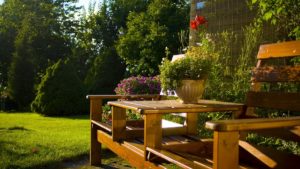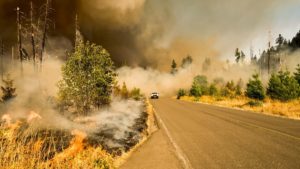27 Nov, 2025 | | No Comments
How To Recycle Your Old Cookware
There are numerous reasons to dispose of old cookware. You may have upgraded to a…
The post How To Recycle Your Old Cookware appeared first on Earth911.
24 Nov, 2025 | | No Comments
Photographic Wonders of China’s Four Sisters Mountain & Siguniangshan National Park
By Nat Hab Expedition Leader Eddy Savage
One of the most striking aspects of the mountains leading up to the Tibetan Plateau is just how huge they are. On our Wild Side of China Photo Expedition, we journey through the Qionglai Mountain range, west of Chengdu, and find ourselves in the foothills of the Himalayas. We pass through the Wolong National Nature Reserve, climb several thousand feet and drive through a series of tunnels to find our view of the mighty Mount Siguniang, which translates to Four Sisters Mountain. Standing at 20,510 feet, Four Sisters Mountain is taller than any mountain in North America (Mount Denali stands at 20,310 feet). We spend the night in nearby Rilong, where we are poised to arrive at Siguniangshan National Park as soon as they open the gates. This UNESCO World Heritage Site boasts sub-alpine coniferous forests, Tibetan villages, herds of domesticated yak, rare sub-alpine birds and tranquil mountain streams that delight my inner photographer. I’ve compiled some of my favorites for your enjoyment.
Our first stop on the way to Siguniangshan National Park is this stunning vista of Four Sisters Mountain. On a clear day, the four peaks can be prominently seen in the distance.

© Eddy Savage
Peaks of Four Sisters Mountain from left to right:
Yaomei Peak – 20,510 ft
Sanguniang Peak – 16,486 ft
Erguniang Peak – 17,310 ft
Daguniang Peak – 17,569 ft
It’s an extraordinary experience getting closer to the park. We drive through Wolong National Nature Reserve, which has broad-leaf deciduous forests at the valley bottom. By the time we climb out of that valley, we are in a mixed coniferous forest—from subtropical to subalpine in just a couple of hours.

© Eddy Savage
There are three large glacially carved valleys within the park. We spend our day in the Shuangqiao Valley and explore over 20 miles of roads and trails at 11,000 to 13,000 feet. Snowfall is always possible whether you’re on a spring or fall departure. However, the mid-day sun usually melts most of it by the afternoon. It always makes for some dramatic scenery.

© Eddy Savage
Heading west in Sichuan Province brings you closer to the Tibetan Plateau. More evidence of Tibetan culture is present as soon as you cross the mountain pass from the Wolong National Nature Reserve.

© Eddy Savage
As a photographer, the vibrance of these Tibetan prayer flags allows for some unique images. I love the contrast between the harsh and rugged mountain and the colorful flags.

© Eddy Savage
The Tibetan prayer flags have writings that promote peace, compassion, strength and wisdom. They blow in the wind, spreading those words to the surrounding land and people for the benefit of all.

© Eddy Savage
Tibetan prayer wheels have prayers and mantras written on them, so spinning them effectively sends the prayer into the surrounding area. They were initially designed for people who were illiterate or could not speak. Some prayer wheels are powered by wind, fire or water. We see lots of these around on our photo expedition, and we spend a lot of time looking for ways to capture their deep meaning in an image.

© Eddy Savage
Lots of rivers and creeks flow down from adjacent hanging valleys. You can see evidence of the harshness of winter everywhere—rockfalls, landslides, floodplains, etc. The main river, however, has found the valley bottom and meanders gently adjacent to the trails and roads we use. Finding that perfect shot is a goal of ours.

© Eddy Savage
This sub-alpine park also offers opportunities for new wildlife. While rare and unlikely to be seen, red pandas inhabit the surrounding forests. Also, altitude-specific birds like the grandala pictured (a member of the Thrush family) may make an appearance.

© Eddy Savage
This tranquil scene is where the valley levels out, and the river widens. The stream is shallow and very slow-moving, and over time, different water levels have occupied the valley bottom. This has allowed clusters of trees to grow in some of the previously exposed land. This is the place to be if you’re looking for epic reflections and foreground.

© Eddy Savage
This area is nicknamed “The Chinese Alps.” The valley is surrounded by numerous 14,000-17,000-foot-high mountains. There is a new dramatic scene around every bend in the road.

© Eddy Savage
As we climb higher into the park, the trees become sparse. Several belts of trees have clung to the mountainsides around the main river tributaries, beautiful and dramatic in contrast to the mountains behind.

© Eddy Savage
The valley is about 20 miles long, and we spend the day on drives and hikes, finding new ways to photograph the scenery.

© Eddy Savage
And finally, being at a higher elevation, we start to see domesticated yaks around every corner. The mountain valleys have been the preferred grazing spot of domesticated yak for hundreds of years, and this is likely the only place we’ll regularly see them on our photo expedition.

© Eddy Savage
Domesticated yaks of all ages greet us along the roadsides and in meadows. I really enjoy being able to photograph them with their habitat so prominently displayed behind them.

© Eddy Savage
The post Photographic Wonders of China’s Four Sisters Mountain & Siguniangshan National Park first appeared on Good Nature Travel Blog.
24 Nov, 2025 | | No Comments
Sustainability In Your Ear: Star’s Tech Hando Choi On Inventing A Low-Carbon, Low-Chloride De-Icer Made From Star Fish
Subscribe to receive transcripts by email. Read along with this episode. What if the solution…
The post Sustainability In Your Ear: Star’s Tech Hando Choi On Inventing A Low-Carbon, Low-Chloride De-Icer Made From Star Fish appeared first on Earth911.
The island of Borneo offers unparalleled opportunities for wildlife photographers to capture the biodiversity of one of the world’s most celebrated rainforests.
Borneo holds about 6% of the world’s biodiversity on just 1% of the planet’s land, with more than 15,000 plant species, 220 mammal species (including 44 that are endemic), and over 420 bird species.
However, much of Borneo’s biodiversity remains under threat from deforestation and other human activities, making conservation efforts critical.
By building a shot list around the ecological importance of Borneo’s wildlife—especially its orangutans—you can craft a compelling visual story that underscores the connection between animals, ecosystems and local communities.
Here’s a guide to six must-capture images that reveal the soul of Borneo’s rainforest—and the stories of the wildlife that depend on it.

Shot 1: Orangutans in Their Natural Habitat — Wide Shots of the Canopy
Orangutans are the stars of the Borneo rainforest, and capturing them in their natural habitat is crucial.
These wide shots can emphasize the vast, towering trees of the lowland rainforests, particularly in the Sepilok Orangutan Rehabilitation Center, where young orangutans learn survival skills before returning to the wild. In the wide shots, aim to make the orangutans small in comparison to the trees to highlight the scale of their habitat and the ecosystem they inhabit.
These images should give viewers a sense of the orangutan’s environment and their dependence on the canopy. Orangutans rarely descend from the trees, so wide shots showcasing the dense, towering forest canopy with an orangutan nestled among the branches provide critical context for their arboreal lifestyle.

Location: Sepilok Orangutan Rehabilitation Center, Kinabatangan River
Photo Goal: Showcase the orangutan’s environment by using a wide-angle lens to capture the forest canopy. Set your aperture to f/8 or higher to maintain depth of field, ensuring the orangutan and its environment are in focus.
Conservation Connection: Emphasizes the importance of preserving the habitat that orangutans rely on for food, shelter and protection. Orangutans are critically endangered, with habitat loss from deforestation being their biggest threat. By showcasing their natural habitat, you can highlight the urgent need for rainforest conservation efforts.
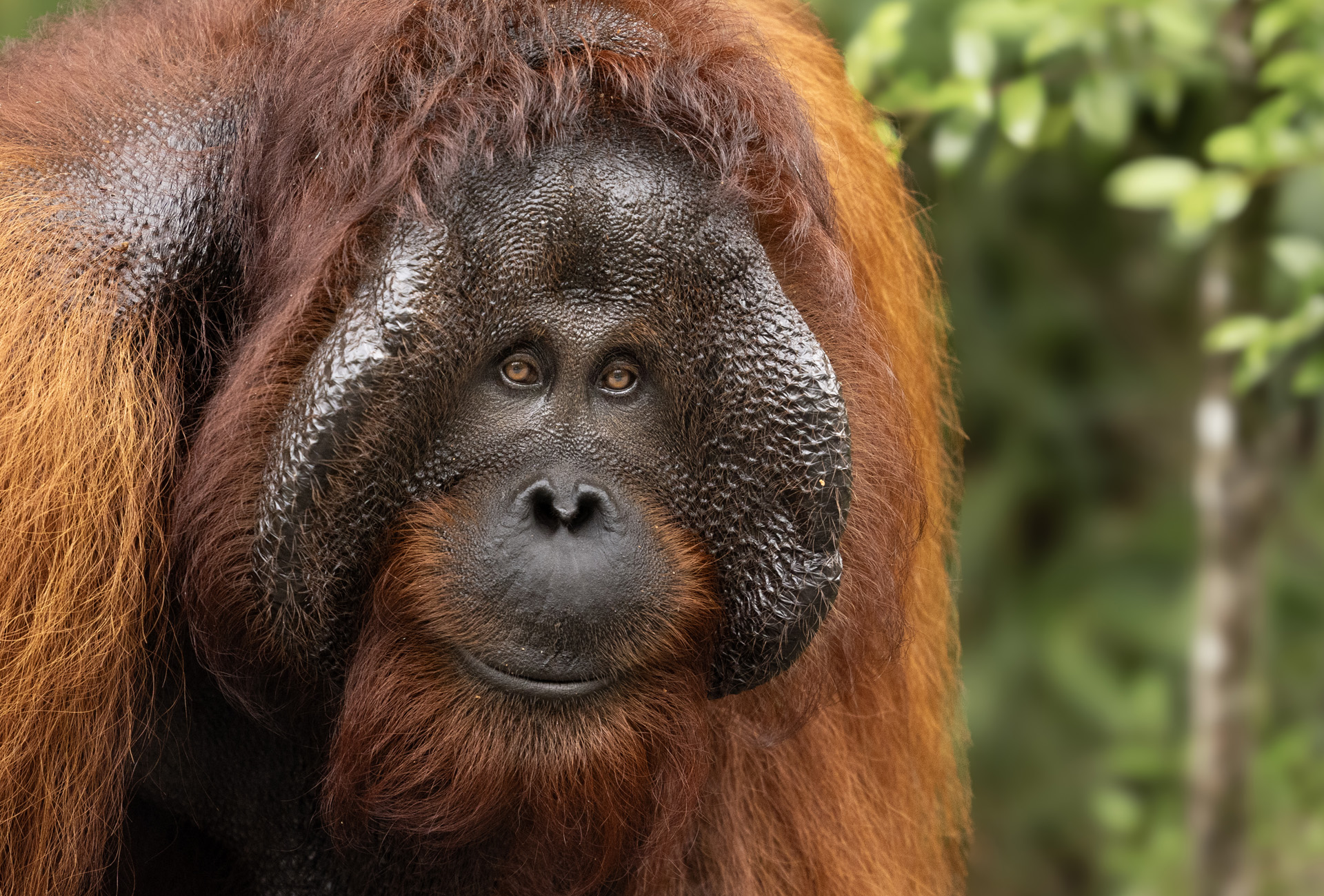
Nat Hab Expedition Leader © Court Whelan
Shot 2: Close-Up of Orangutans Feeding — Medium and Tight Shots
Orangutans are essential seed dispersers in the forest, and capturing this behavior is important for illustrating their ecological role. Zoom in to catch the detailed action of an orangutan eating, especially if it’s discarding seeds—a behavior that helps regenerate the rainforest.
Tight shots should show the texture of their fur, their dexterous hands and the fruits they’re consuming. These images emphasize their key role in the ecosystem, as orangutans help spread seeds throughout the forest floor, ensuring plant biodiversity.

Location: Sepilok Orangutan Rehabilitation Centre, Danum Valley Conservation Area
Photo Goal: Use medium and tight zoom lenses to capture the intricacies of feeding behavior and the connection between orangutans and the fruits they consume. A focal length of 200–400mm is ideal for isolating the subject while maintaining enough distance to avoid disturbing them. Aim for a fast shutter speed to freeze motion while the orangutan is actively eating.
Conservation Connection: Reinforces the orangutan’s role as a keystone species in maintaining the health of the rainforest. Without orangutans, many plant species in Borneo would lose their primary means of seed dispersal, affecting the entire forest ecosystem.
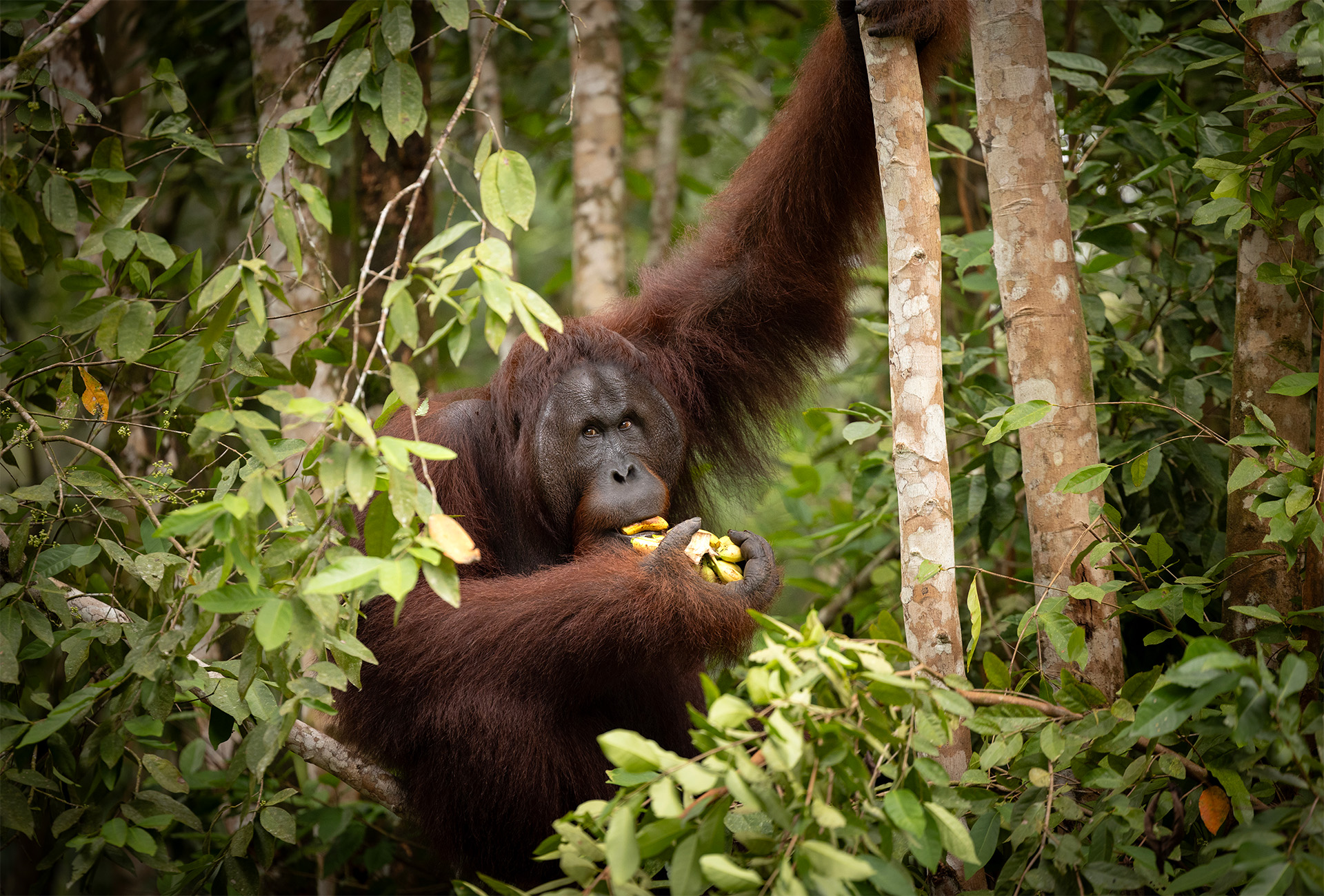
Nat Hab Expedition Leader © Court Whelan
Shot 3: Unique Wildlife Along the Kinabatangan River — Proboscis Monkeys in the Trees
The Kinabatangan River is home to a wide array of wildlife, including the distinctive proboscis monkeys, which are endemic to Borneo. As you cruise along the river, look for opportunities to capture these monkeys high in the trees, their exaggerated noses adding character to the frame.
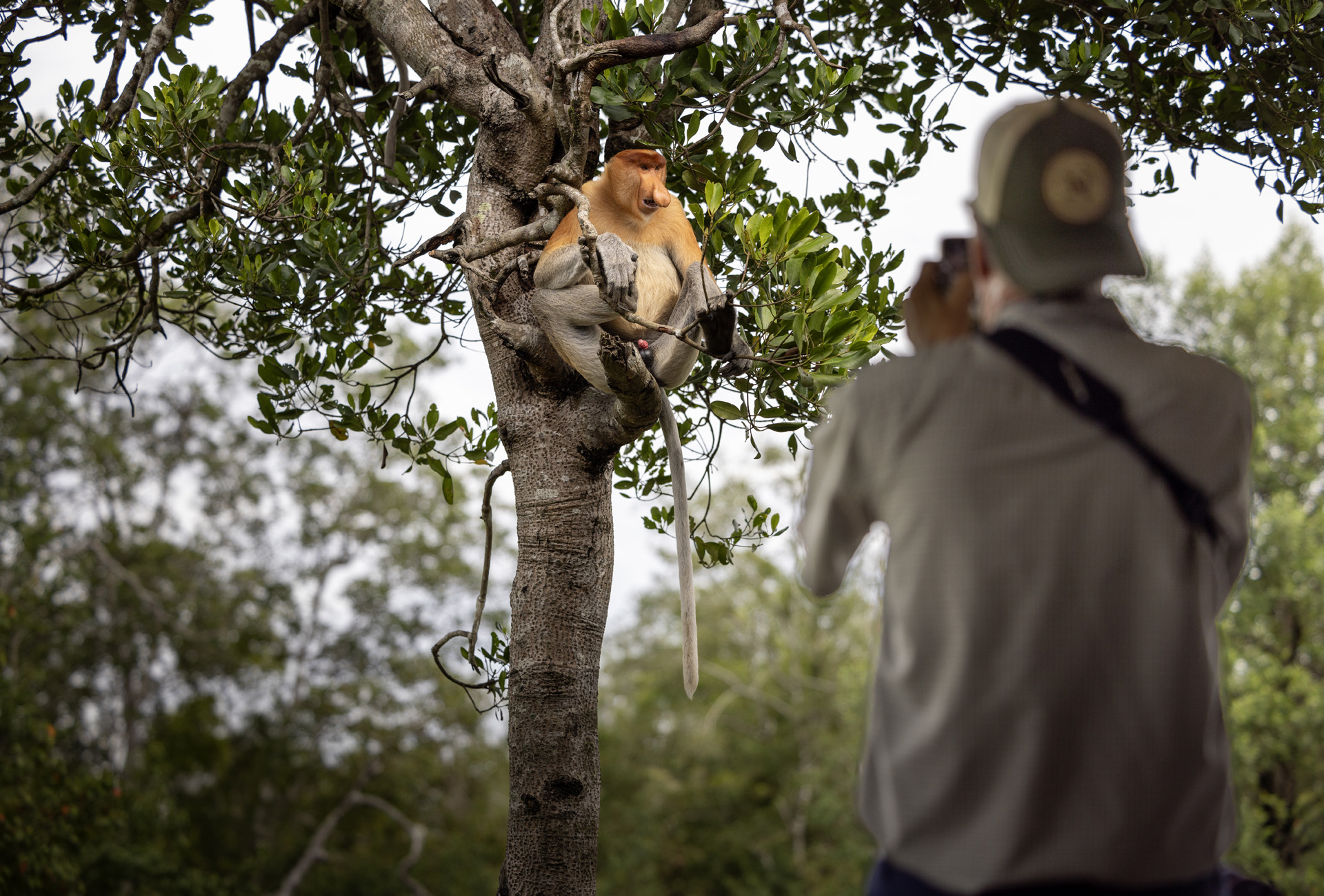
Nat Hab Expedition Leader © Court Whelan
Consider shooting at sunrise or sunset to bathe the scene in golden light, offering a warm contrast to the greenery of the rainforest.
Proboscis monkeys are often seen in large social groups, making for dynamic shots that show both the individual characteristics of the monkeys and their interactions within their troop. These shots can serve as an additional story element to complement your orangutan focus, showcasing Borneo’s overall biodiversity.
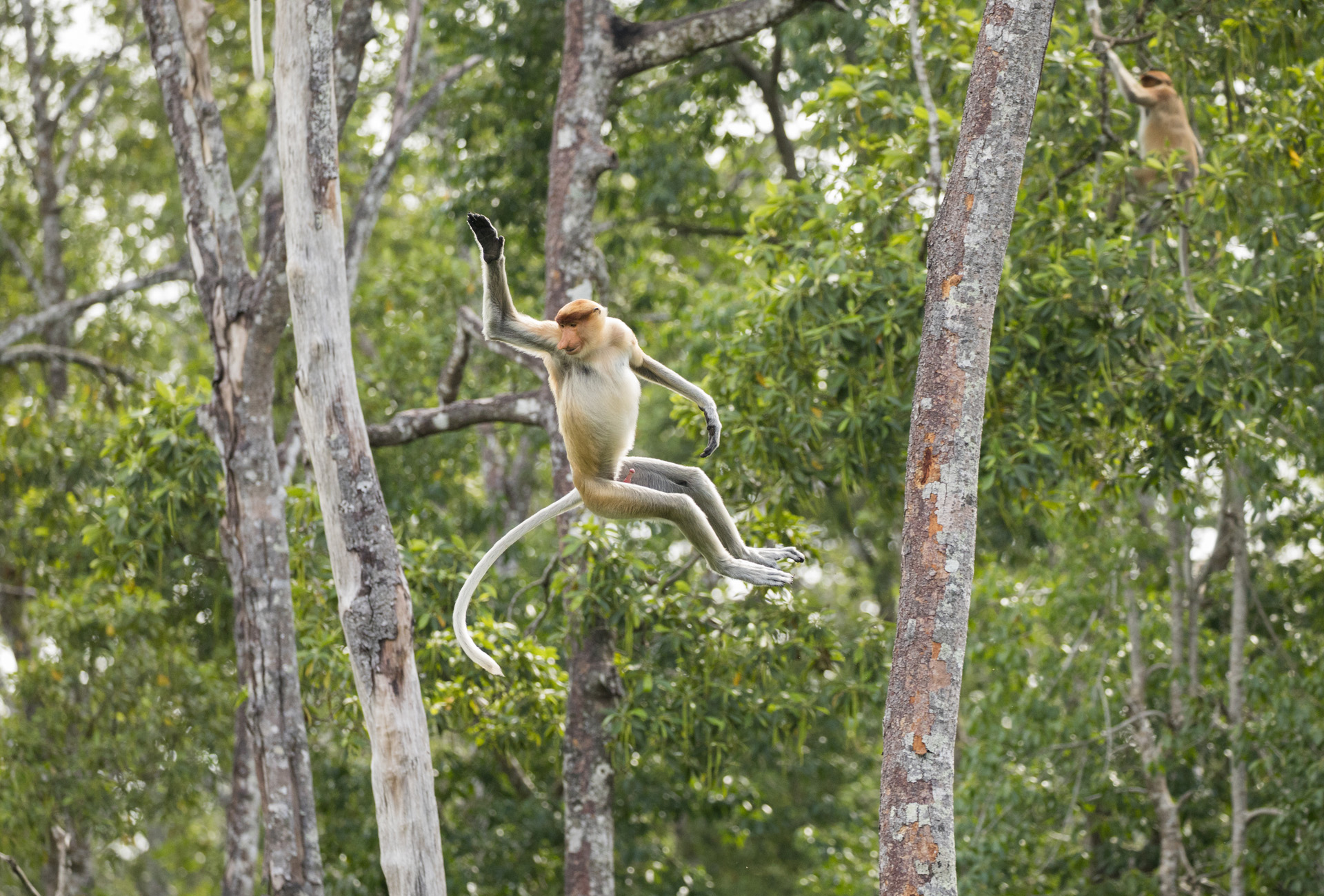
Nat Hab Expedition Leader © Court Whelan
Location: Kinabatangan River
Photo Goal: Capture the unique features of proboscis monkeys with a medium lens while showing them interacting in groups. To enhance color contrast, adjust your white balance for warm tones when shooting at golden hour. A lens in the 70–200mm range is perfect for capturing group dynamics and expressions while maintaining distance.
Conservation Connection: Highlight Borneo’s unique species and the importance of preserving the riverine ecosystems that support them. Proboscis monkeys rely on the health of these ecosystems, which are increasingly threatened by deforestation and palm oil plantations.

Nat Hab Expedition Leader © Court Whelan
Shot 4: Portrait of a Pygmy Elephant — Close-Up of an Endangered Species
Borneo is home to the endangered pygmy elephant, and getting a close-up portrait of this rare species can be a highlight of your trip. While cruising the Kinabatangan River or exploring the Danum Valley, keep your camera ready for encounters with these gentle giants. Portraits should focus on the elephant’s eyes, tusks and skin texture, creating an intimate connection between the viewer and this endangered species.

Capturing an image of a mother elephant with her calf can add another layer of emotional impact, showcasing the familial bonds within elephant groups. This also reinforces the conservation message, as pygmy elephants face significant threats from habitat loss and human-wildlife conflict.
Location: Kinabatangan River, Danum Valley Conservation Area
Photo Goal: Use a tight zoom lens to capture an intimate portrait, focusing on the texture and details of the elephant. Set your aperture to around f/4 to create a shallow depth of field, ensuring the elephant’s face is sharp while the background is softly blurred. This isolates the subject and adds emotional impact.
Conservation Connection: Raises awareness of the plight of Borneo’s pygmy elephants and their fight against habitat encroachment. Pygmy elephants are classified as endangered, with fewer than 1,500 left in the wild.
Shot 5: Rainforest Flora and Local Fruits — Wide and Close-Up Shots
The tropical plants and flowers of Borneo’s rainforests are vibrant and diverse, making them ideal subjects for wide shots of the forest floor or close-ups of individual plants. Focus on capturing the colorful and intricate details of rainforest flowers, such as orchids, which are plentiful in the Danum Valley. These flowers play a crucial role in the ecosystem and are often overlooked in wildlife photography.
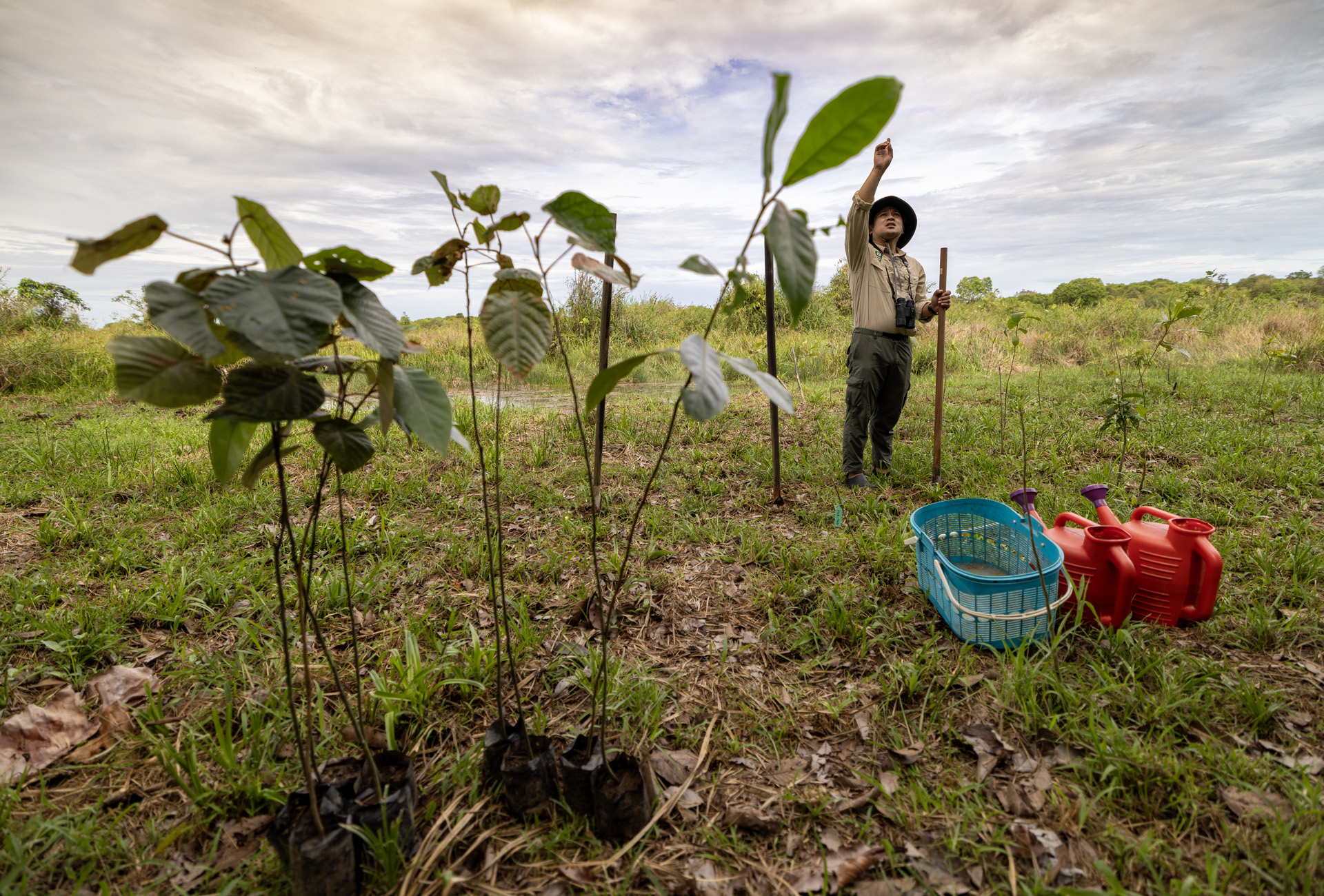
Nat Hab Expedition Leader demonstrates sustainable agriculture. Photographed by © Court Whelan
In addition to wild plants, local fruits found in Borneo’s markets offer a human connection to the rainforest. Capturing the fruits—such as durian, mangosteen or rambutan—can illustrate the connection between the forest and the livelihoods of local communities. Adding a human element, such as a market vendor or a person eating fruit, broadens the narrative and ties human life to the rainforest.

Nat Hab Expedition Leader © Court Whelan
Location: Danum Valley, Local Markets in Sandakan
Photo Goal: Capture both wild rainforest plants and fruits in local markets, focusing on texture and color. Incorporate humans where possible. A macro lens can be helpful to get close-up details of the intricate textures of flowers and fruits.
Conservation Connection: Demonstrates how humans rely on the forest for food and how the health of the rainforest supports local economies. Many fruits sold in local markets are directly linked to rainforest biodiversity.

Nat Hab guest looks up to the canopy. Photographed by Expedition Leader © Court Whelan
Shot 6: Orangutans and Their Offspring — Emotional Connection with Tight Portraits
Photographing orangutans with their offspring provides not only a heartwarming image but also a powerful message about the importance of protecting these vulnerable animals. In the wild, mother orangutans stay with their young for up to eight years, teaching them essential survival skills.

Capturing this bond with close-up shots of mother and child will resonate with viewers, fostering a connection that can motivate action toward conservation efforts.
Location: Sepilok Orangutan Rehabilitation Centre, Kinabatangan River
Photo Goal: Use a tight zoom lens to focus on the emotional bond between orangutan mothers and their young. A focal length of 300mm or higher will allow you to capture intimate expressions while maintaining distance. Consider shooting in soft light to emphasize the gentle interaction between mother and child.
Conservation Connection: Highlights the vulnerability of young orangutans and the necessity of protecting their habitat for future generations. Orangutans are critically endangered, with their population decreasing due to illegal logging, palm oil plantations and hunting.

© Brad Josephs
Crafting a Conservation Narrative
Creating a shot list that encompasses a wide range of wildlife, flora and human elements allows you to capture and share a compelling conservation story during a Borneo Wildlife Photo Expedition. Whether you focus on orangutans as keystone species or explore the interconnection between wildlife and local communities, each shot can play a role in educating and inspiring conservation action.
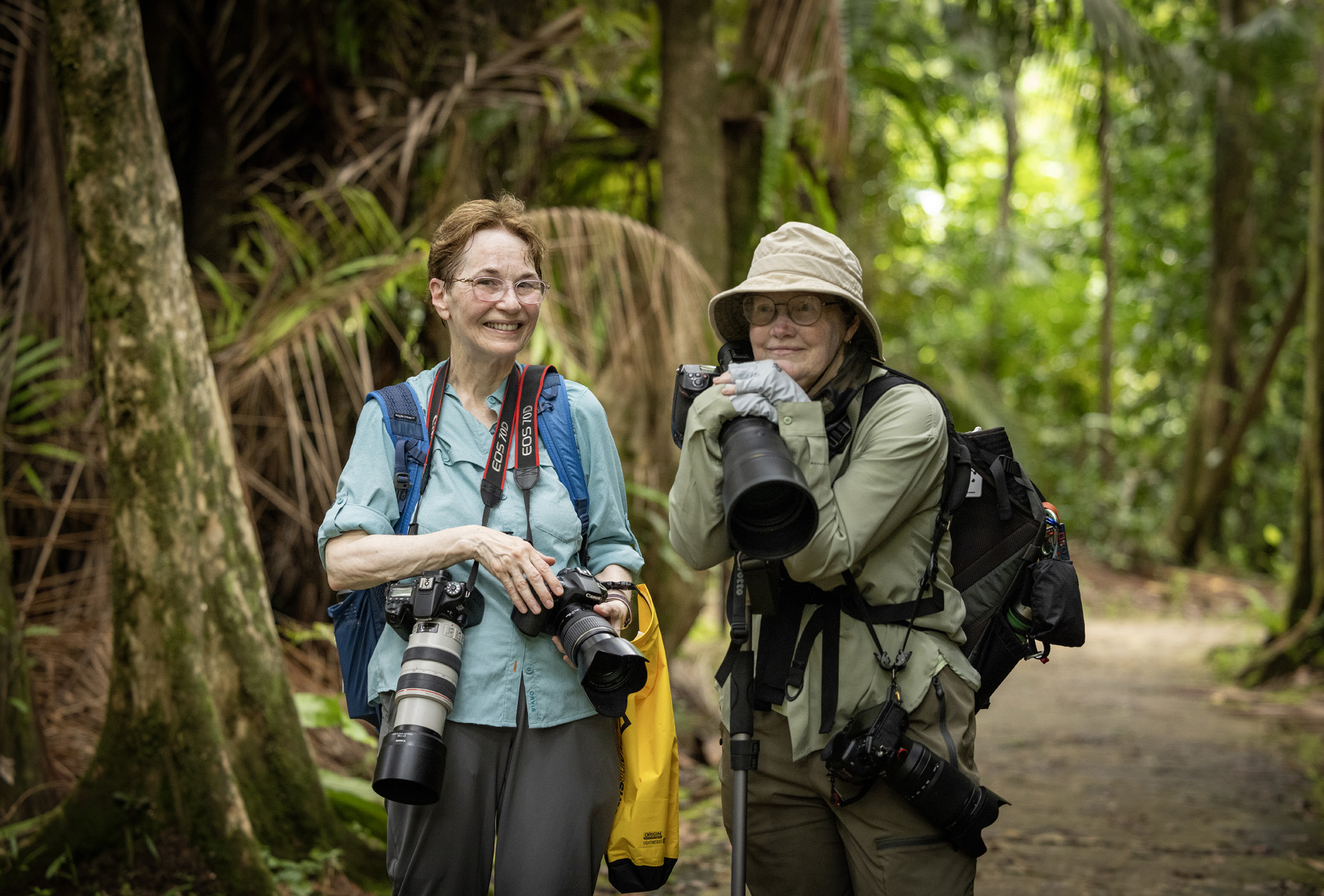
Nat Hab guests. Photographed by Expedition Leader © Court Whelan
Want to get started in conservation photography? Nat Hab Expedition Leader and Chief Sustainability Officer, Court Whelan emphasizes,
“To me, the key to success is aiming for simple stories that you connect with. Could you create a photo essay on the importance of orangutans to the ecosystem? This is absolutely conservation-focused and accomplishes the goal of educating and motivating action on a species you’re likely to see.”
With this shot list and a deeper understanding of Borneo’s wildlife, landscapes and conservation challenges, you’ll be ready to capture powerful photos that showcase Borneo’s beauty and inspire others to protect it, too.
Want to Know More About Borneo and Travel There?
Whether you’re preparing for your upcoming Borneo adventure or just want to learn more about this lush island, Nat Hab has you covered. Check out our Know Before You Go page for an array of helpful resources, from wildlife and weather guides to firsthand accounts written by Nat Hab travelers and staff. You’ll especially want to check out the orangutan photo tips!

Nat Hab Expedition Leader beside a proboscis monkey. Photographed by guide © Bedley Asun
The post Wildlife Photography in Borneo: 6 Shots That Tell a Conservation Story first appeared on Good Nature Travel Blog.
23 Nov, 2025 | | No Comments
Guest Idea: Chicago High School Students Launched Eccodrone To Fight Litter
Enjoying the environment should be about connecting with Earth, not a neon-colored plastic wrapper. Imagine…
The post Guest Idea: Chicago High School Students Launched Eccodrone To Fight Litter appeared first on Earth911.
A love for the environment comes naturally with a love for the outdoors. Unfortunately, we…
The post How To Create an Environmentally Friendly Oasis in Your Backyard appeared first on Earth911.
8 Sep, 2025 | Admin | No Comments
Sustainability In Your Ear: Author and Activist Bill McKibben Brings The Sun

Listen now and read a transcript of this episode. Introducing Sustainability In Your Ear transcripts…
The post Sustainability In Your Ear: Author and Activist Bill McKibben Brings The Sun appeared first on Earth911.
In the past, every American could recite Smokey Bear’s slogan: “Only you can prevent forest…
The post Wildfire Prevention: Where Safety and Environmentalism Connect appeared first on Earth911.
The days are getting shorter, and winter will be here before you know it, so…
The post 6 Energy-Saving Tips for Colder Weather appeared first on Earth911.
Autumn may be in the air, but the change in seasons doesn’t require a complete…
The post Let There Be Light: How To Build a Gardening Cold Frame appeared first on Earth911.
